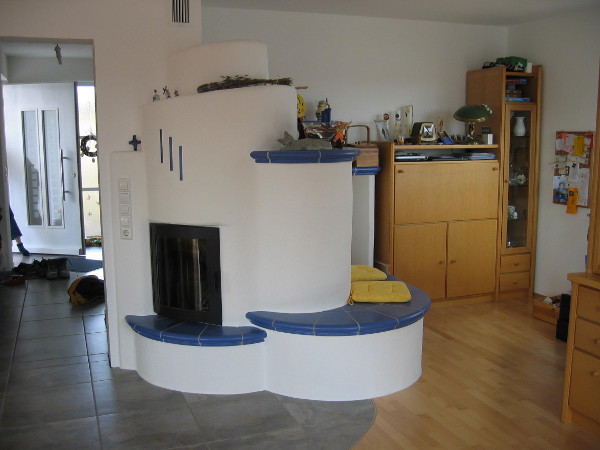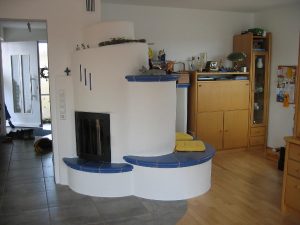“Masonry stoves offer good solutions to many of the problems associated with wood burning. They provide clean combustion at a high temperature, good efficiency, a high degree of safety, and little or no pollution.” – David Lyle
Contents
What are masonry stoves?
Masonry stoves are domestic wood-burning heating appliances with an internal firebox made of refractory (heat-resistant) fire bricks, and a system of flues within the stove, made from the same material. The entire stove will contain between one and five tonnes of masonry. A kachelofen (German), kakelugn (Swedish) or kakkelovn (Norwegian) is a type of masonry stove. Kachel means tile, so a kachelofen is a tiled stove. Masonry stove is a generic term that includes stoves without tiles.

Fire bricks have a high (c. 40%) alumina content, and 60% silicate material. The flue system can be from 3-9 metres in length – with both vertical and horizontal lengths – and is connected to a chimney. Heat and flammable gases travel through the flue system and the masonry soaks up the heat and slowly releases it into the environment. The temperature of the gases at the exit from the stove (i.e. at the base of the chimney) is typically 100-150°C, compare to 300-400°C with a normal wood stove, as most of the heat has been absorbed by the masonry. Masonry stoves minimise heat loss via the chimney, although you still need a warmish chimney to create a draw.
The masonry absorbs and re-emits so much heat that a fierce fire for a couple of hours a day is enough to heat your home all day. A system of primary, secondary and tertiary air jets (basically, holes in the side of the firebox) bring an abundance of oxygen into the combustion chamber to maintain a very clean burn. The air jets are not just at the bottom and front of the firebox, but also at the sides, back and top. The main air intake could be from the room or from the exterior of the house. The masonry has insulating properties, so it heats up and cools down slowly, and stores heat longer than metal.

The four most common facing materials for the outside of a masonry stove are:
All react well with heat, without cracking. Different parts of the world favour different facing materials (stoves are more or less the same inside). The most common facing materials in North America are brick and stone; in Russia, brick and render; in Germany, tiles and stucco; and in Scandinavia, tiles and soapstone.
History
The Roman hypocaust was a massive stone structure with a large firebox and flues under the floor. The hot masonry radiated heat for public baths, but required slaves to stoke the fire day and night. The masonry stove that we know today began to appear in the 15th and 16th centuries, in central and eastern Europe. In the 17th and 18th centuries, Scandinavian monarchs funded research into better stove designs due to shortages of fuel. Germans, Scandinavians and eastern Europeans took the masonry stove idea to the US, and only now are they beginning to appear in western Europe, notably Spain, the UK and France.
Before fire bricks existed, engineering bricks with clay mortar were used; and before that, clay bricks and clay tiles. The inside of the firebox was re-plastered with clay plaster every year, to protect the bricks. Clay-based mortars containing ground porcelain were used between the bricks. Modern mortars are made from ground fire bricks mixed with clay powder, water glass (sodium silicate) and other materials – often secret (masonry stove builders tend to have their own recipes).

What are the benefits of masonry stoves?
In an ideal situation, a masonry stove should be able to burn 980g of material and leave only 20g of ash from 1kg of wood. Combustible gases don’t ignite until they reach around 800°C – easily achievable in a masonry stove. By allowing abundant oxygen into the combustion chamber, masonry stoves can reach a combustion efficiency of 95-98% (a modern, clean-burning wood stove is around 80% efficient, and an old stove maybe 60%).
Then there is heat transfer efficiency – i.e. how well the heat created transfers into the room. Metal is much denser than masonry, and its surface gets much hotter. Air molecules vibrate violently, causing many collisions near to the stove. Lots of energy is used up heating the air. The surface of a masonry stove is much cooler, and heat radiates out more gently, avoiding the violent collisions between air molecules. Heat tends to move further through the air until it hits a solid surface – walls, furniture or people. In a room heated by a masonry stove, you have warm walls, furniture and people, but the air is still relatively cool and fresh.
Here are some more benefits:
- They use wood – a renewable and carbon-neutral resource
- Their efficiency means less wood used and virtually no smoke emissions
- They don’t break down. They are huge solid things that last generations – there are plenty of working stoves in Europe over 100 years old
- Independence – you don’t have to rely on corporations for your heating and hot water
- Safety – if you have small children around, the surface is not too hot to touch
- Chimney doesn’t have to be swept so often – virtually no tar, creosote and other pollutants

What can I do?
Using a stove
You light a fire in the firebox once a day, using 10-20kg of wood, allow it to burn fiercely for a couple of hours, and then close it down by shutting the chimney damper to stop the air flow. Apart from the once-a-day burn, when it comes to firewood, kindling, removing ash etc, it’s the same as a normal wood-burning stove (except that much less ash is produced).
Getting a stove
It’s probably best to get an experienced professional to build and install your stove, or if you really want to do it yourself, then do it alongside someone with experience, or attend a course where you can try it yourself under supervision. There are lots of things to keep in mind. For example, there needs to be a gap between the fire bricks and the facing, because the bricks expand when heated, and so they need space to expand into.

Different materials such as fire bricks, stone, metals (if present), clay etc. have different rates of expansion and contraction, and so the sizing and spacing of components is crucial. You don’t want cracks to appear that may allow carbon monoxide to escape. Also, combustible gases could become trapped in the flueways if they’re not built correctly, and could cause an explosion when the stove is re-lit. Of course there are similar risks with wood stoves – it all comes down to common sense in the end. Masonry stoves have been used in Europe for a long time, and are perfectly safe if installed and used correctly.
A masonry stove represents a whole-house heating system – i.e. it will provide your hot water as well. A system for a 3-4 bedroom house can cost several thousand pounds, but is competitive with other whole-house systems built from scratch. It will use 3-4 tonnes of wood per year (based on 20kg of wood per day), and depending on the source / price of your wood, represents a payback time of around 5-6 years. Gas is relatively cheap nowadays, but will rise in price as it begins to run out. And of course, your stove will last a lifetime without any maintenance or repair bills – unlike any other whole-house system.
A masonry stove will give you around 0.7-1kW of output per m² of exterior surface area, and a standard size is around 5-6kW. They’re not specifically mentioned in building regs yet, but a good installer will be HETAS registered, and will build, certify and test your stove. A stove can take a week to install, will be designed for a particular home, and will therefore be unique. However, some builders have developed modular stoves that can be put together in a day, and are therefore cheaper because of the reduced labour costs. They won’t be as efficient as an individually-designed stove though.
For more information on masonry stoves, there are lots of good books out there, but very few in English. Ken Matesz’s book is very good – it contains everything you could want to know except the precise details of stove design. Masonry stove builders like to keep their trade secrets!
For professionals: the Austrian Tile Stove Association has design software in German for around €3000, plus €1500 per year for a licence. European Standards provide a couple of documents in English for around £100 each – EN 15544 (20 pages of firebox and flueways dimensions) and EN 15250 (80 pages on testing stoves). Kiwa Gastec is a government-approved testing station for solid fuel appliances that can test masonry stoves for around £10k.

Appliances need to be Defra-approved, tested and certified to be used in a smoke-control area. The problem with masonry stoves though, is that they are unique, and not based on a model that can be tested. In Germany, if an installer has followed the design software, the stove is considered efficent and clean enough to be certified. Martin of StoveMason.com tells us that all his customers so far have been outside smoke-control areas, in small towns and in the countryside.
If you’re going to get a masonry stove installed, you may as well make it work as much as possible. A stove can be tall enough for the top to emerge into a first-floor room, to heat upstairs as well; we’ve already mentioned hot water; it can also include an oven and a hob for cooking; and the flueways can be diverted to heat an adjacent, very cosy bench.
Thanks to Martin Ruzicka of StoveMason for information.



7 Comments
I live in Galicia, Spain, where the winters are cool and damp. I’d like to install a masonry stove/kachelofen, but I don’t feel competent to do it on my own. Would anyone know of experienced people or professionals in this corner of Spain who might be able to offer advice? Thank you!
Martin Ruzicka from StoveMason.com is teaching this summer in Suffolk, UK. He will work with a small number of students to construct a masonry stove in the new Meeting Room at Orchard Barn.
Course dates: 9-13th July 2019 9.30-4.00 , including open Seminar 9th July
Number of places: 6
Venue: Orchard Barn, Suffolk, IP14 2LY
http://Www.orchardbarn.org.uk
Please email Sarah [email protected]
Is there anyone in the US who builds these gorgeous things? or anyone who ships to the US?
Is masonry stove heated with gas burners prohibited by EU law?
F.A.O. Janet Kias
Try https://www.permies.com
a USA based permaculture group that has lots of information on masonry/rocket mass heaters.
I am certain there will be something for you.
Our family has an old Kacheloven in Switzerland, is heating the living room entirely with it. My question would be how high should/could the surface of the Tiles of the Kacheloven (centre) be reaching without any danger overheating the oven? How much wood to insert to build the fire and the approx. time to add another pile of wood.
I most thankful for some information which I can pass on to this household.
Thank you
Hi, we have recently built a masonry stove and it’s working really well. We love it, however we rendered it with lime and it’s cracking and beginning to crumble off!
A professional applied the render.
Any suggestions would really help